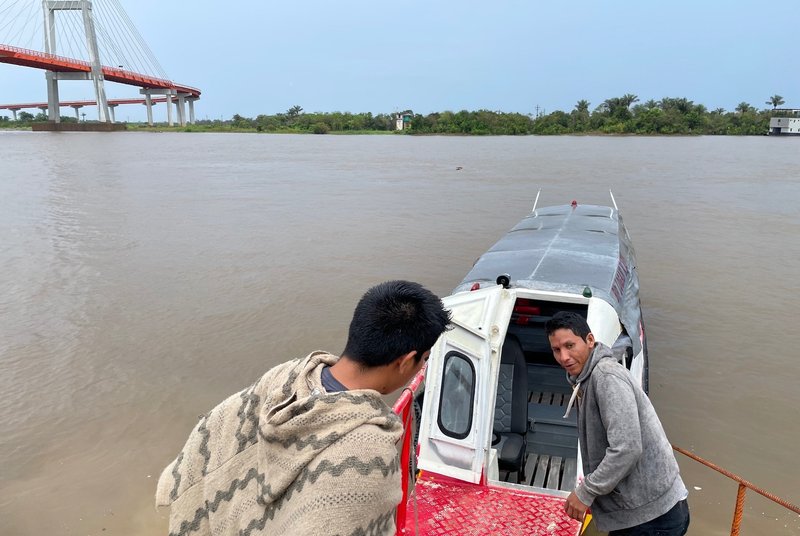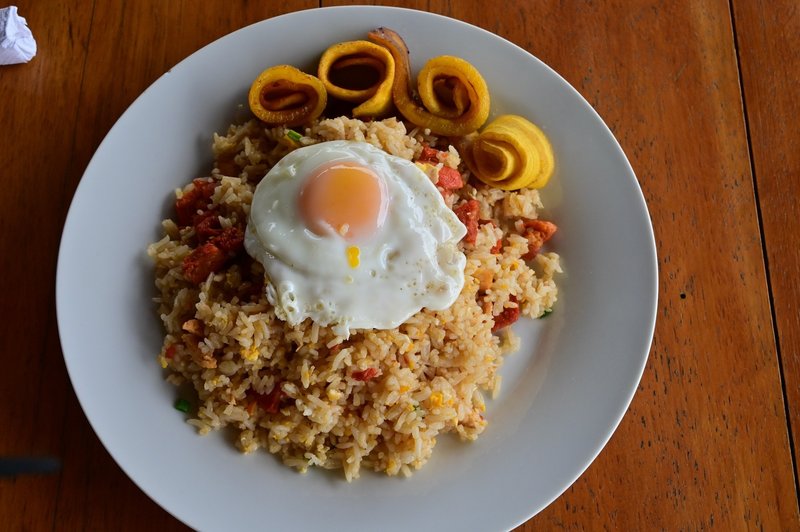
ペルー編4:ジャングルの川に浮いた宿でアマゾン料理三昧
反政府デモによりクスコ空港閉鎖
2023年2月15日早朝5時、僕たち、ザ・ハーブスメン一行はリマ空港から国内便に乗り、アマゾンの陸の孤島の街イキトスへと向かった。
English Follows Japanese
前日にペルーに着いて最初の食事となった「セントラル」でのランチを終え、宿に戻ると午後5時になっていた。満腹なのと時差ボケが重なり、横になった瞬間に眠ってしまった。そして、夜中過ぎの午前2時前に起き出して、宿を一旦チェックアウトした。既にロビーに待機していたザ・ハーブスメンの水野仁輔さん、シャンカール・ノグチさんともにタクシーに乗り、二日前に通ったばかりの幹線道路を戻り、リマ空港に戻ってきた。

なぜイキトスに行くことになったのか。元々、ザ・ハーブスメン一行はマチュピチュ遺跡への入口としても知られるアンデス山脈の町クスコの郊外にある「セントラル」の姉妹店「ミル・セントロ」を訪れる予定だった。ミル・セントロではインカ帝国の農業試験場跡と言われるモライ遺跡やお店の農園を周り、アンデス山脈の食材についてレクチャーを受けた上で、地域食材を使ったフルコースをいただく目論見だった。
だが、ペルーでは2022年末から新大統領ボルアルテの辞任や議会の解散を求めて全土で大規模なデモが頻発していた。1月下旬になるとデモは激化し、クスコの空港は閉鎖されてしまった。残念ながらミル・セントロ行きは諦めざるを得なくなった。同時期にリマからペルー南部へと続く幹線道路も封鎖された。外国人旅行者にはクスコとマチュピチュ遺跡だけでなく、ペルーを代表するもう一つの観光地のナスカの地上絵への道も閉ざされてしまったのだ。

アマゾンの陸の孤島の町イキトスへ
そんなときシャンカール・ノグチさんが「それではアマゾンに行きましょう! イキトスはどうですか?」と言い出した。
イキトスはペルー北東部に位置するアマゾン川上流の人口50万人の港町。熱帯雨林に囲まれているため、陸路は存在せず、アマゾン川をブラジルの河口から3700kmもひたすら遡るか、飛行機でしかたどり着けない。そんな隔絶された環境では、リマやクスコでは拡大する一方の政治デモの影響も全くなさそうだった。
イキトスかあ……。スパイスハンターを自称するシャンカールさんは、アマゾンの赤唐辛子に興味を持ったらしい。一方、僕は2019年にフィンランドのタンペレで開催されたワールド・ミュージックのエキスポ「WOMEX」で、1960年代からイキトスで活動を続けるクンビア楽団「Los Wemblers de Iquitos」を観て、イキトスという街に興味を持っていた。お爺さんのエレキギタリスト兄弟とその息子たちが演奏するのは、コロンビアのダンス音楽「クンビア」がアマゾンのジャングルでサイケデリックに生まれ変わった「アマゾンのクンビア」だ。
更に調べると、イキトスの中心から船に乗り、アマゾン川の支流を遡ったところにある、川に浮いた屋形船状の宿「Amazon Oasis Lodge」を見つけた。真夜中や夜明けのアマゾンを楽しめるならば、町の普通のホテルに泊まるよりも良いじゃないか。その場でリマ・イキトスの往復航空券とAmazon Oasis Lodgeを予約した。
アマゾン川に浮かぶ宿
リマからイキトスは直線距離にして約1000km。2時間弱のフライトの後、イキトスの空港には午前7時に到着した。気温は28℃ほどだが、ジャングルのど真ん中だけに湿度がやたらと高い!

荷物を受け取り、宿が手配してくれたタクシーに乗り込むと、途端に激しいスコールが降り出した。40分ほどのドライブでイキトス中心街を通過し、完成したばかりで、まだGoogleマップにも掲載されていなかったナナイ橋(2024年2月現在は掲載済み)を渡って、アマゾン川の支流、ナナイ川の船着き場に着いた。その頃にはすっかりスコールは止んでいた。そこからは細長いモーターボートに乗り換え、ナナイ川を遡り、更に支流のモモン川に入ると、5分ほどでAmazon Oasis Lodgeに到着した。これから二日間、川に浮いた宿に逗留するのだ。



宿は川に浮いた5つの建物が横に並んで繋がっている。真ん中の一番大きくて二階建ての建物がレストランとレセプション、二階が厨房、その奥はマネージャーのセサールの家族が暮らす棟になっている。そこから左右に2つずつお客用のロッジが竹の通路で連なる。要は客室は全部で4つしかない。そのうちの3部屋を僕たちザ・ハーブズメンが独占することとなった。

部屋は木造で、川に面した手前側がオープンテラス兼船寄せになっている。そこからダイレクトに川に飛び込むことも、釣りをすることも出来る。テラスにはハンモックも常備。室内も広さ20㎡ほどあり、四方に網戸が張られた広い窓があり、湿度は高いが、風がよく通って意外と快適だ。ただ、トイレとシャワーは水上のためどうしても簡易的な造りだ。電気は太陽光発電で夜間の照明は最小限。インターネットはWIFIがあることはあるが、速度は遅い。SNSに長い動画を投稿するのは無理そうだ。

モモン川は川幅が50mほどで、宿の後ろの岸も向こう岸も川面まで木々の枝葉が垂れ下がり、奥には鬱蒼としたジャングルが広がっている。川には小さな手漕ぎボートが浮かび、釣り師たちが釣り糸を垂れていた。そして、数分毎に通勤や通学、買い物のための地元民で満員の中型ボートが目の前を通る度に波が起き、宿自体が大きく揺れる。

僕は部屋に入るとすぐに荷物を広げ、水泳パンツに着替え、ゴーグルをして、テラスからモモン川へと助走を付けて飛び込んだ。ザッバーン! 川の底まで潜ろうとしたが、川は深く、足は底まで着きそうにない。水中から見上げると、水は明るいカフェオレ色、太陽の光を集めて光っているように見える。これは樹木から流れるタンニンの色だそうだ。雨が降った直後だったので、水はそこそこ冷たい。向こう岸まで1往復泳いでから、水から上がると、肌がスベスベになっていた。これは気持ち良い! 一日何度でも水に入りたい。

後で聞いたところ、川の深さはなんと約20m。雨季のため、乾季と比べて約15mも水面が上昇しているのだそう。怖~! ピラルクやワニに足を噛まれて引きずり込まれなくて良かった! 次回からはライフジャケットを着て泳ごうっと。

初めてのアマゾン料理
早朝からの移動でお腹が空いたので、宿でランチを頼むことにした。というか、滞在中は宿で食べるしかないのだ。

メニューはシンプルにA4サイズ一一枚。その場でグーグル翻訳を使ってスペイン語を訳すと、セビーチェ、チチャロン(フライ)、ア・ラ・プランチャ(グリル)、スダード(蒸し煮)、ガルニシオーネ(付け合せ)、飲み物、それ以外には前菜や飯物。
セビーチェは魚をドンセヤ(タイガーショベルノーズキャットフィッシュという大型のナマズ)かパイチェ(世界最大の淡水魚ピラルク)、またはラガルト(ワニ)から選ぶ。体長3mほどのピラルクか、体長1.5mほどのタイガーショベルノーズキャットフィッシュか。どちらも日本ではまったく口にすることのない淡水魚だ。
チチャロンとア・ラ・プランチャも、それぞれドンセヤ、パイチェ、ラガルト、そしてポヨ(鶏肉)から選ぶ。スダードもドンセヤかパイチェのどちらか。そして付け合せはキャッサバかジャガイモまたはバナナのフライ、甘くないバナナの団子のタカチョなど。更にチャウファ(炒飯)や、前日に「セントラル」でも口にした謎のアマゾン・ベーコンことセシーナなど。

とりあえず初めてのアマゾン料理ということで、パイチェ=ピラルクのセビーチェと、同じくパイチェのスダード(蒸し煮)、鶏のチチャロン(フライ)、そしてチャーファ(炒飯)を頼んだ。
最初に運ばれてきたのはチャーファ。シンプルな卵炒飯だが、小さく刻んだオレンジ色のベーコン=セシーナが肉の良い味を出している。豚にしては脂が少ないので、何の肉かとセサールに尋ねると、カピバラ肉のベーコンと判明した。ヒー!カピバラさん、ごめんなさい! 日本では愛玩動物のカピバラはアマゾンでは立派な食用動物だったのだ!

世界最大の淡水魚ピラルクのセビーチェ
続いてはパイチェ=ピラルクのセビーチェ。僕は今回ペルーに着いて初めて食べるセビーチェだ。サイコロ切りした魚の白身に紫玉ねぎと香菜、アヒリモ(赤唐辛子)が和えられ、付け合せには蒸かしたキャッサバ、甘く煮たオレンジ色のサツマイモ、そして塩煎りしたピーナッツ。淡白な白身魚に香菜、ニンニク、レモン汁、そして塩がシャッキリと効いていて美味い! 川魚を生で食べるのは100%安全とは言えないが、アマゾンまで来てそんな無粋なことは言ってられない! 世界最大の淡水魚ピラルクの身は、その凶悪な外見からは想像つかないほど、素直な味がする。モソモソの食感のキャッサバや甘いサツマイモ、カリカリのピーナッツとの相性もバッチリだ。

そして続いて、同じくピラルクのスダード。これはピラルクのフィレをフレッシュなトマトと生姜、ニンニク、香菜、レモン汁で短時間で蒸したもの。生姜を使った蒸し料理のテクニックは日系人の調理人によってペルー全土に広まったと聞く。確かに煮込んでしまったら、ピラルクなど身の柔らかい白身魚は崩れてしまうだろう。そして、鶏のチチャロンはフライドチキンと言うより、衣が分厚い天ぷらで、如何にも田舎の味がする。どれもなかなかに美味い。

夕飯には大型ナマズのドンセヤやワニのセビーチェを食べようか。これから二日間、アマゾンの素朴な地元料理を食べまくるにあたり、川に浮いた宿でのランチはなかなか悪くないスタートとなった。

ペルー編をまとめてマガジンにしました。こちらもご利用下さいませ!
Iquitos: Amazon Cuisine at a River-floating Lodge Amidst the Jungle
Airport Closure Due to Anti-Government Protests
On February 15, 2023, at 5 a.m., we, The Herbsmen, boarded a domestic flight from Lima to Iquitos, an island city in the Amazon.

After our first meal in Peru at "Central" and returning to our accommodation at 5 p.m., we immediately fell asleep due to a combination of full stomachs and jet lag. Waking up just before 2 a.m., we checked out and, along with fellow Herbsmen members, Hisuke Mizuno and Shankar Noguchi, took a taxi back to Lima Airport, retracing the route we had taken two days prior.

Our initial plan was to visit "MIL CENTRO," a sister restaurant of "Central" located in the outskirts of Cusco, a gateway to the Machu Picchu ruins. MIL CENTRO focuses on ingredients from the Andes, unlike Central which utilizes ingredients from all over Peru. We intended to tour the Moray ruins, believed to be an Incan agricultural experiment site, and enjoy a full course meal made from local ingredients. However, due to large-scale protests demanding the resignation of the new President Boluarte and the dissolution of parliament, which had been escalating across Peru since late 2022, Cusco Airport was closed. Consequently, our visit to MIL CENTRO had to be canceled. Additionally, the main highway from Lima to the south of Peru was also blocked, cutting off access not only to Cusco and Machu Picchu but to another major tourist attraction, the Nazca Lines.
To Iquitos, an Amazonian isolated city
In light of these circumstances, Shankar Noguchi suggested a trip to the Amazon. "How about Iquitos?" he proposed. Iquitos, a port city in the northeastern part of Peru with a population of 500,000, is surrounded by rainforest, making it accessible only by navigating up the Amazon River from its mouth in Brazil or by airplane. The political protests in Lima and Cusco seemed to have no effect on this isolated region.
Shankar was intrigued by the Amazon's red chili peppers, while I had been interested in Iquitos since seeing a performance by "Los Wemblers d'Iquitos," a cumbia band active since the 1960s, at the WOMEX world music expo in Tampere, Finland, in 2019. Their music represented a psychedelic transformation of the Colombian dance music "cumbia" in the Amazon jungle.
Further research led us to "Amazon Oasis Lodge," a floating lodge on the Amazon River, accessible by boat from Iquitos. The unique location promised an enjoyable experience far from the ordinary city hotels. We immediately booked round-trip flights from Lima to Iquitos and accommodations at Amazon Oasis Lodge.
At Amazon Oasis Lodge
After a flight of less than two hours covering approximately 1000 km, we arrived at Iquitos Airport at 7 a.m. Despite the high humidity and temperature of 28°C, a sudden downpour greeted us as we drove to the lodge. Arriving at the Nanay River, a tributary of the Amazon, we transferred to a slender motorboat and headed upriver to Amazon Oasis Lodge.
The lodge consists of five interconnected floating buildings. The central structure houses the restaurant and reception, with the kitchen on the second floor and the manager's family residence at the back. Four guest lodges extend from the central building, connected by bamboo walkways.
Our rooms, constructed from wood and directly facing the river, offered direct access to the water for swimming or fishing. Despite the high humidity, the breeze through the large, netted windows kept the rooms surprisingly comfortable. However, the water-based facilities were understandably basic, and electricity was limited to minimal nighttime lighting from solar panels. Internet access was available but slow.
The Momon River stretches about 50 meters wide, with branches and leaves drooping down to the water surface on both banks, revealing the dense jungle beyond. Small rowboats floated on the water, with fishermen casting their lines, while medium-sized boats filled with locals commuting, attending school, or shopping passed by every few minutes, stirring waves that made the lodge sway significantly.
Amazonian Cuisine
Upon arriving at my room, I quickly unpacked, changed into swim shorts, donned goggles, and dove into the Momon River from the terrace. The river, surprisingly deep, seemed to glow a bright café-au-lait color due to the tannins flowing from the trees. The water was somewhat cold, a consequence of the recent rain. Swimming to the opposite bank and back, I emerged with my skin feeling smooth and refreshed, eager to dive in again at any chance. I later learned the river is about 20 meters deep during the rainy season, rising about 15 meters higher than during the dry season. I was relieved not to have been dragged under by pirarucu or crocodiles. Next time, I'll remember to wear a life jacket.
Hungry from the early morning journey, we decided to dine at the lodge, our only option during the stay. The menu was a simple A4 sheet. Translating from Spanish with Google, the options included ceviche, chicharron (fried), a la plancha (grilled), sudado (steamed), garnishes, drinks, and other starters and rice dishes. Choices for ceviche were doncella (a type of large catfish), paiche (the world's largest freshwater fish), or lagarto (crocodile). Chicharron and a la plancha offered the same selection, including chicken. Sudado was available with doncella or paiche, and sides included cassava, potatoes, or banana fries, among others. Additionally, there were chifa (fried rice) and, as tasted at "Central" the day before, Amazon bacon known as cecina.
My First Amazonian Cuisine
After moving since the early morning, I was hungry and decided to have lunch at the lodge. Actually, dining at the lodge was our only option during the stay. The menu was simply a single A4 size sheet. Translating the Spanish on the spot with Google Translate, the options included ceviche, chicharron (fried), a la plancha (grilled), sudado (steamed), garnishes, drinks, along with appetizers and rice dishes. For ceviche, the choices of fish were doncella (a type of large catfish), paiche (the world's largest freshwater fish), or lagarto (crocodile). Chicharron and a la plancha also allowed choices from doncella, paiche, lagarto, and chicken. Sudado could be either doncella or paiche. Side dishes included cassava, potatoes, or fried bananas, among others. Additionally, there were chifa (fried rice) and, as tasted at "Central" the day before, Amazon bacon known as cecina. For our first taste of Amazonian cuisine, we ordered paiche ceviche and sudado, chicken chicharron, and chifa. The first dish served was chifa. It was a simple fried rice but enhanced by small diced pieces of orange-colored bacon = cecina, adding a great flavor to the meat. When I asked Cesar what kind of meat it was, due to its low fat content, it was revealed to be capybara bacon. Oops! Sorry, capybara! In Japan, capybaras are considered pets, but in the Amazon, they're a proper food source.
The World's Largest Freshwater Fish Paiche Ceviche
Next was the paiche ceviche, my first time eating ceviche since arriving in Peru. Diced white fish mixed with purple onions, cilantro, and aji limo (red pepper), served with steamed cassava, sweetened orange-colored sweet potatoes, and roasted peanuts. The combination of the bland fish with cilantro, garlic, lemon juice, and salt was delicious! Eating river fish raw isn't 100% safe, but when you're in the Amazon, you can't be bothered with such concerns. The taste of the world's largest freshwater fish, paiche, was surprisingly straightforward despite its menacing appearance. The texture of cassava, the sweetness of sweet potatoes, and the crunchiness of peanuts were all perfectly matched. Following that was the paiche sudado, which is the fillet of paiche steamed for a short time with fresh tomatoes, ginger, garlic, cilantro, and lemon juice. I heard that the technique of using ginger in steaming dishes spread across Peru thanks to Japanese cooks. Indeed, if overcooked, the soft flesh of fishes like paiche would disintegrate. The chicken chicharron, more akin to a thickly battered tempura than fried chicken, had a very rustic taste. All the dishes were quite delicious. For dinner, maybe I'll try the large catfish doncella or crocodile ceviche. As a start to two days of indulging in the rustic local cuisine of the Amazon, lunch at the floating lodge was a rather good beginning.
この記事が気に入ったらサポートをしてみませんか?
